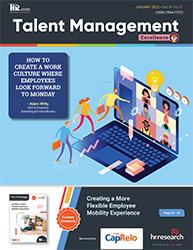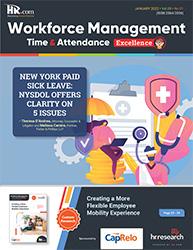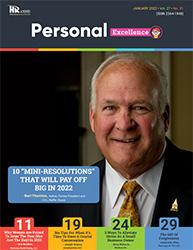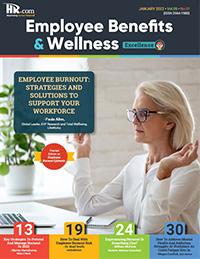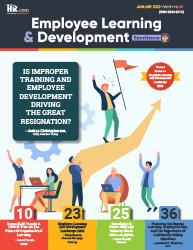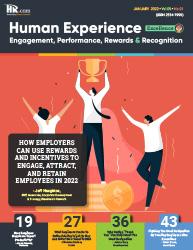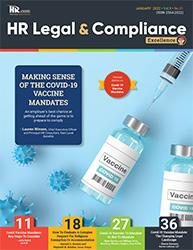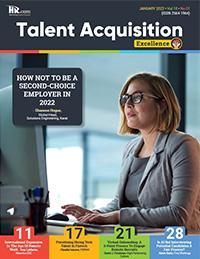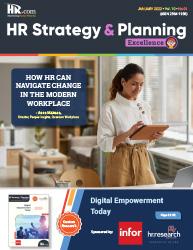




A simple guide for sourcing success
- Kevin W. Grossman, President, Talent Board
10 You Can’t Risk NOT Assessing Your Candidates’ Language Skills Why is it essential to vet prospective employees for proficiency in a second language they claim to have before hiring them?
Articles 31 Skills-Based Hiring Paves The Way For Upward Mobility Employers need to hire people for skills, not pedigree - Deeneaus Polk Founder, 3LEVATE, and Jenna Shrove, Senior Director of Strategic Advocacy, U.S. Chamber of Commerce
- Gosia Jaros-White, Director, Sales & Marketing, Language Testing International 15 5 Data-Driven Insights
Key ways to tell your best story and stand out to recently laid off big tech employees
- Jim Galligan, Director, Creative Strategy, JK Design

Positioning TA to support your workforce needs
- Amy Bush, President, Sevenstep
What Do You Need To Become A Recruiter? 3 TA leaders share their second career stories - Part III - Jennifer Allen Newton, President, Bluehouse Consulting Group, Inc. 39 What You Need to Know
And Firing
Global Workforce The globalization of a business involves the need to exploit business opportunities to enter new markets and to deal with business threats - Dr. Shan Nair, President, Nucleus


For 2023
Learn how to set recruiters and HR professionals up for success - Cory Stahle, Economist, Indeed Hiring Lab
3 key steps for diversity recruiting success - Joanna Kuang, VP, Product Development and Impact and Bias Trainer, Illumen Capital
The State Of The Staffing Industry: Top Trends to Watch In 2023 (And Beyond)

Staffing proves highly beneficial when the global economic situation is in turmoil

- Rich Thomas, Chief Operating Officer, Pyramid Consulting, Inc.
Refining the recruiter experience
- Sean Behr, CEO, Fountain
Our mission is to promote personal and professional development based on constructive values, sound ethics, and timeless principles.
Debbie McGrath CEO, HR.com - Publisher
Sales
Chinnavel Design and Layout (Digital Magazine)
Vibha Kini Magazine (Online Version)
Please send any correspondence, articles, letters to the editor, and requests to reprint, republish, or excerpt articles to ePubEditors@hr.com
For customer service, or information on products and services, call 1-877-472-6648
For Advertising Opportunities, email: sales@hr.com
Acquisition Excellence (ISSN 2564-1964)
is published monthly by HR.com Limited, 56 Malone Road, Jacksons Point, Ontario L0E 1L0
Internet Address: www.hr.com
Matt Charney Editor-in-Chief, Talent Acquisition Excellence
In recruitment, like in the oil business, a significant portion of our capital expenses and infrastructure are dedicated to building a pipeline; there’s a tremendous cost associated with extraction (sourcing) and candidate development (refining, to continue the oil metaphor). Therefore, it makes sense to store any associated surplus, whether those are candidates or oil, until there’s sufficient market demand.
Dropping this extended metaphor for one moment, the idea of pipelining is obviously one that makes a lot of sense in talent acquisition; in theory, it sounds like the perfect strategy to ensure that there’s always an available supply of qualified talent available with the experience and expertise recruiters are looking for.
Sourcing and engaging this surplus of talent, of course, takes a significant amount of time, as proactively finding and engaging mostly passive talent, particularly those with hard to find skill sets or niche industry experience, requires building a real relationship based on mutual trust; pipelining true top talent is anything but transactional or short term.
Open reqs, however, must be filled efficiently and effectively, regardless of relative market scarcity or candidate supply. Since even the best talent forecasts are inherently flawed (which explains why, in a recent HR.com research report on The Future of Talent Acquisition, fully 3 in 4 TA organizations planned on either cutting or freezing headcount in 2023, compared with the 87% who reported planning to add headcount going into 2022), this makes pipelining something of an inexact science, at best.
The Great Resignation has retired, replaced with the concept that boom times may well have gone bust.
Hiring is just in time, all the time, and candidates, like any commodity, are valued almost exclusively dictated by short term demand relative to available supply of qualified candidates and the market competition for them.
These factors, like all variables in the business of talent, are imminently dynamic and unpredictable, and for the most part exist beyond the control of even the most carefully constructed workforce plans and talent forecasts.
That means that most of the time, our pipelines are, at best, leaky – and, despite our belief that the bigger the pipeline or talent pool, the better it will be for our employers, the fact is that timing is everything. That’s true for employers actively filling reqs, of course, but it’s equally true for top talent.
A candidate with high job satisfaction or engagement is unlikely to consider other opportunities; they’ll be more receptive to building relationships with recruiters
Copyright © 2023 HR.com. No part of this publication may be reproduced or transmitted in any form without written permission from the publisher. Quotations must be credited.
Dawn Jeffers VP, Sue Kelley Director (Product, Marketing, and Research) Babitha Balakrishnan and Deepa Damodaran Excellence Publications Managers and Editors Matt Charney Editor-in-Chief Deepa Damodaran Editor– and consequently, entering a pipeline or talent pool – when their job satisfaction is lower, their career growth is declining or they’re actively disengaged at their current roles.
If you’re a recruiter looking to build a pipeline, however, telling the difference between the two prior to engaging them is an exercise in futility, and engaging a potential candidate around future opportunities if they’re currently looking, or for an open role if the timing isn’t right, effectively creates blockage in any pipeline that can not only disrupt the process for placeable candidates, but can lead to leaks, and ultimately, an empty pipeline.
Why is it, then, that sourcing is so inefficient? How can we do a better job with matching our candidates – internal and external, passive and active – to jobs so that we can move from building expensive infrastructure to an on demand model, which negates the need for pricey infrastructure like dedicated sourcers, talent CRMs or “talent communities?”
Most importantly, how can we anticipate how much pipeline capacity we’re going to need in the first place at a time when the headlines are filled with stories about layoffs and cutbacks, so soon after going on a post-pandemic hiring binge? Employment is cyclical; effective sourcing, and candidate communication, are secular.
No matter how severe any impending downturn might get, the inevitable fact remains that hiring will roar back, a perpetual cycle of feast and famine, of candidate scarcity and abundance. Reference unemployment numbers and job growth remain surprisingly strong in most sectors
That’s why developing meaningful, impactful and personal communications with candidates today will go a long way in ensuring that tomorrow, when hiring picks back up, your pipeline will be your lifeline - and your ultimate competitive advantage, since most organizations will be effectively starting their sourcing functions and talent funnels from scratch.
We’re kicking off our annual ed cal here at Talent Acquisition Excellence by taking a deep dive into sourcing and candidate communications. It’s only apropos to start 2023 where every talent acquisition process starts, at the very beginning (a very good place to start), and take a look at some of the biggest trends, tips and tools shaping sourcing and talent acquisition today.
From taking a data driven look at the rapidly shifting list of what candidates really want when they’re looking for a job today, to talking shop about how the staffing industry is weathering the perfect economic storms of inflation, hiring slowdowns and the growing impact of automation, take it straight from our source.
We might not have a ton in here on how to build Boolean Strings, perform wildcard searches or scrape esoteric databases just to score a couple candidates, but this issue Talent Acquisition Excellence is all about how to suck less at sourcing.
The bylines in this magazine, from the CEO of one of the world’s largest RPOs to the head of the Talent Board to one of the leaders of the world’s leading job site, represent voices who are not only experts on what’s new and what’s next in sourcing, but are also actively influencing that future, too.
Which is pretty cool, all things considered.
Happy Hiring.


This monthly interactive learning experience captures key metrics, actionable items and keeps you focused on developing yourself and corporation as top leaders in the Talent Acquisition space.

Talent Acquisition Virtual Events offer webcasts and demos on topics in any of the staffing related programs: Contract Workforce and Talent Exchanges, Online Staffing and Sourcing, Recruitment Process Outsourcing, or Quality of Hire. Learn how to bring the right staffing and recruiting programs into your organization and make them impactful. Listen to the world’s top thought leaders in the staffing industry as they help companies make decisions in all areas of staffing and recruiting. Each Virtual Event consists of up to 10 credit webcasts.
HR.com webcasts deliver the latest Talent Acquisition industry news, research trends, best practices and case studies directly to your desktop. Webcasts are available live online with a downloadable podcast and a copy of the slides (PDF) available before and after each webcast. Earn all of the required recertification credits for aPHR, PHR, SPHR, GPHR, and SHRM Certifications. HR.com’s one-hour webcasts, in every HR specialty including Talent Acquisition, are pre-approved for HRCI and SHRM credit (excluding Demo webcasts).
Join almost 55,000 HR.com members with a similar interest and focus on staffing and recruiting topics with one of the four staffing related online communities: Contract Workforce and Talent Exchanges, Online Staffing and Sourcing, Recruitment Process Outsourcing, or Quality of Hire. Share content and download research reports, blogs, and articles, network, and “follow” peers and have them “follow” you in a social network platform to communicate regularly and stay on top of the latest updates. This well established Community is an invaluable resource for any HR professional or manager.
How difficult will sourcing qualified candidates be in 2023?
Judging by the data in the latest Talent Board benchmark research, recruiters and HR professionals are anticipating a continuing sourcing struggle. Which is why more than half (51%) of the North American employers Talent Board surveyed plan to purchase AI-based technologies in 2023 to bolster their sourcing efforts,
and talent acquisition (TA) teams have cited “targeted sourcing” as one of their top 10 priorities in the coming year.
These figures should not come as a surprise to anyone who has been paying attention to the talent market lately. In the wake of the Great Reshuffling and mounting global talent shortages, TA teams everywhere are scrambling to find promising new sources of qualified

candidates. Of course, once these sources are identified, the real challenge begins: building relationships with high-potential candidates and keeping them in your talent pipeline until they are successfully hired.

Relationship building and sustaining candidate engagement are largely about effective communication. In the early sourcing and attraction stages of recruiting, your TA team needs to deliver the employer brand content and specific information that interest candidates most, utilizing the channels and technologies candidates prefer and responding quickly to inquiries and questions. Companies that excel at these actions gain a significant competitive advantage, particularly in a talent market as competitive as the current one.
Let us take a closer look at some of the most crucial communications-related data points and insights from Talent Board’s newest candidate experience research.
Our 2022 findings show that candidates want three things in the early stages of the recruitment/sourcing process: 1) a clear understanding of a company’s values; 2) insight into the company’s employee experience; and 3) a sense of connection with the overall brand.
Did you notice that job-related information is not at the top of the list? Of course, candidates want to know specifics about a job they are interested in, and sometimes is just about getting the job regardless of potential cultural issues. However, an astounding (and growing) number of them want to know other things
first. What kind of company is this? What are its mission and values? How does it treat its people? Will the work I do there be meaningful? Many individuals today just briefly scan the job descriptions that usually do not give them the answers to these questions.
Indeed, we have learned that far too many workers were not aligned with their company’s mission and values. And too many were not finding purpose or meaning in their work. These disconnects helped to fuel the existential employee exodus, and they continue to be among the reasons many workers still have not reentered the workforce, preferring to sit on the sidelines rather than take another meaningless job. This makes it all the more imperative that employers openly promote their companies’ mission, values, culture, and reasons why others actually work there.
Talent Board’s 2022 research shows that when it comes to marketing your company and employer brand:
● Values are king The number one type of marketing content candidates consumed during their jobs research in 2022 was about company values, with 48% of all candidates citing it as the most important type of content they look for. Values-related content rose in importance an incredible 109% from 2021.
● Culture is crucial Nearly one-third of the thousands of North American job candidates we surveyed said they want more information about company culture. This is corroborated by a wealth of data from other researchers, some of which shows that culture is as important as compensation if not more so And when it comes to showcasing your culture, be specific about issues, such as diversity and inclusion (27% of the candidates we surveyed want more DE&I information) and why people want to work for your company (27% also want more information about this).
● Candidates want to hear from your employees
— Your employees are your most powerful and persuasive marketing resource, especially in the early sourcing and candidate attraction stages of recruiting. The reason is simple: job seekers trust your company’s employees three times more
than other company sources to provide credible information on what it is like to work there.

In Talent Board’s experience, companies that post employee testimonials, videos, and other types of employee-authored content across their Careers sites, social media, and employer review sites like Glassdoor, Indeed, and Fairy Godboss frequently have the most highly rated candidate experiences. Interestingly, however, employee testimonials have lost a bit of their credibility over the past few years, according to Talent Board’s research. In our discussions with candidates, this is due to concerns over the validity of testimonials controlled by corporate management. This is why we also encourage employers to allow their employees to create and post spontaneous, unedited content and to vigorously enforce a no-recriminations policy when employees do so.
● Careers sites top favored research channels — Too many TA teams still underestimate the importance of their company’s Careers site, posting just the bare essentials in their jobs descriptions and company information. It Is the first destination candidates go to once they are interested in an employer or a job. Forty-two percent of North American candidates cited Careers sites as their most valued research channel in 2022.
(Employers’ LinkedIn pages were the second most valued channel, cited by 30% of candidates, and online groups, such as Facebook and Yahoo were third, cited by 27% of candidates.) Your Careers site should provide a rich, multimedia, multi-language experience to job seekers. Nearly one-third (31%) of candidates in 2022 said they want more Careers sites in multiple languages.
● Candidates want you to provide a snapshot of success — Candidates are keen to understand what a successful candidate profile looks like once they are interested in a job—something that increased in importance by 75% in 2022. And their interest in success does not end there: more and more of them want to see career path examples, which increased in importance
by 29%. This is not a surprise, as a lack of advancement was the reason 63% of workers gave for abandoning their jobs in 2021.
These are the new keys to building a strong and resilient talent pipeline. Like so many other aspects of recruitment, sourcing is an active and consistent engagement process — one that needs to respond and adapt to changes in the talent market and your company’s changing talent needs.
However, one thing that should not change, even if your most fruitful sources do, is your commitment to solid candidate communications. In today’s talent market people are seeking new and more meaningful work, as well as new workplace cultures that are better aligned to their own personal values and career goals.
This affords you a perfect opportunity to showcase your company, what makes it unique, and why the work you offer has meaning and gives your employees a sense of purpose.
Kevin W. Grossman is the President of Talent Board and the Candidate Experience Awards. Kevin has over 23 years of domain expertise in the human resource and talent acquisition industry and related technology marketplace. He’s been a prolific industry writer since 2004 and his first business book on career management titled Tech Job Hunt Handbook was released in December 2012 from Apress. His second book titled Candidate Experience: How to Improve Talent Acquisition to Drive Business Performance will be released in 2022 by Kogan Page.
Would you like to comment?
 By Gosia Jaros-White, Language Testing International
By Gosia Jaros-White, Language Testing International

we continue to be more linguistically and culturally diverse, providing services to customers in their preferred language becomes a necessity. As many as 75 percent of consumers say they are more likely to purchase a product if customer support is provided in their preferred language. More than half would spend more on a product if a company provided information in their own language. Therefore, customer-facing roles require candidates to be proficient in languages other than English.
Hiring the right language-proficient multilingual candidates to help with the growing need for multilingual customer service builds your brand loyalty in target ethnic markets and turns prospective customers into loyal clients. It can also help mitigate risks, such as complying with laws and
regulations that require culturally and linguistically clear communication; lackluster year-to-year revenue growth due to the inability to adequately expand into diverse markets; and unsatisfactory non-English speaking customer experience.
It is not enough these days to simply believe what people put on their resumes about their language proficiency. A survey of 2,000 hiring managers by Hloom, a company that provides templates for cover letters and CVs, found that the second worst lie an applicant could put on their CV was foreign language fluency. Another survey has shown that almost 60% of job applicants overstate their abilities, including their language proficiency.
Why lie? Candidates tend to exaggerate where it is difficult to draw a clear line, so language ability is an item that tends to be overstated. In addition, language fluency is hard to gauge if it is not supported by an official language certification. Phrases such as “Fluent in. . .”, “Conversant in . . .”, or “Working knowledge of . . .” are often included on resumes with no explanation or proof of actual proficiency.
As
Why is it essential to vet prospective employees for proficiency in a second language they claim to have before hiring them?
Hiring bilingual talent without verifying their language proficiency leads to miscommunication and carries a risk of legal ramifications and loss of credibility. According to a recent report, as many as 67% of employers believe that miscommunication due to language barriers contributes to inefficiencies and 37% believe that customer service suffers when the employees cannot efficiently communicate in the language their customers prefer.
There are several benefits of making language assessment a part of your recruitment process.
Requiring your job candidates to take language tests early in the recruitment process allows you to quickly filter out those, who do not possess the required level of proficiency. Once you identify those who do demonstrate a sufficient proficiency level, you can then focus on other skills and talents required for the job. In addition, language tests such as the ACTFL language proficiency assessments can be administered online or over the telephone anytime and anywhere over secure networks, eliminating the need for job candidates to come to your office to take the test.
Reliable language assessments can help you standardize your recruitment process, eliminating subjectivity and bias. Before you begin testing job candidates, you should establish the minimum level of proficiency for each role and then measure all candidates against that metric. Language Testing International (LTI), along with a group of Industrial and organizational psychologists, developed the LTI Task Analysis process to assist companies in establishing minimum proficiency levels for bilingual positions. By using standardized methods, you ensure a fair recruitment process, and you can easily defend your hiring decision as all candidates are measured against the same criteria.
Reliable and valid language proficiency assessments eliminate the guesswork on whether candidates who claim to be fluent truly possess the language skills required for the job and ensures you select candidates who are best suited for the roles.
Partnering with an experienced and reliable language assessment provider is a simple solution to ensure that prospective new employees possess the appropriate level of language proficiency.
As the largest and most respected language assessment provider globally, Language Testing International (LTI) works with corporate clients to test language proficiency of prospective candidates and current employees. With 30 years of experience providing language assessments to the corporate sector, LTI administers nearly a million tests annually in over 120 languages. The independent process mitigates the risk of unfair employment or advancement processes and of customers claiming inferior service in their native language. The certification results are legally defensible; decades of research and practice assure the reliability and validity of each assessment.
Gosia Jaros-White is a bilingual marketer with almost 20 years of experience in educational publishing and EdTech. She holds a master’s degree in applied linguistics from Montclair State University. She has spent most of her career creating and developing materials for English language learners and is passionate about language, language education, and assessment. Would you like to comment?

Employers, HR professionals, and recruiters typically take the beginning of the year to review highs and lows and strategize how to improve upon or build new processes, procedures, or standards regarding hiring and retention. As they do, it is critical that these groups understand the labor market – both in its current and potential future forms as trends indicate – to know what to expect for recruiting, hiring, and retaining talent moving forward.
A firm grasp on what the future of work looks like will set recruiters and HR professionals up for success, allowing them to set priorities based on trends we expect to see come to fruition in 2023.
Today, we are taking a closer look at what these trends are, as identified by Indeed and Glassdoor economists, and what they mean in 2023.
Hiring was at a boom in the earlier part of 2022, with one in five workers indicating they planned to quit their job this year. For employers, this meant a focus on recruiting – doubling down on efforts to land top-tier talent and creating efficiencies to quickly move from application to interview and to hire. Just a few short months later, a looming recession seems more likely, and as rapidly as we saw hiring increase,
we are now seeing layoffs and hiring freezes emerging just as fast.
One key trend to anticipate is that attracting, hiring, and retaining workers will remain challenging in 2023 and beyond. We expect that these hiring difficulties will be driven by demographic trends – particularly from an aging labor force which is the result of increased retirements and slowing U.S. birth rate. In a tight labor market where we may face labor supply constraints, coupled with layoffs and hiring freezes, HR professionals and recruiters must get more creative and open-minded with hiring practices when needs arise.
This includes implementing tactics like attracting and hiring workers from abroad while looking strategically at company and state immigration laws and policies. Also, looking at overlooked pools of workers to deepen the well of potential prospects. This can mean finding ways to open up talent pools of workers that may be typically passed over despite the skill set they offer, like many of those with criminal records. Additionally, employers may consider altering or adopting flexible workplace practices to accommodate those with disabilities or those caring for children, among other groups.
If employees have any say, remote work is certainly here to stay – if it is offered as an option. For about one-third of the workforce where jobs can be conducted remotely, these workers have become accustomed to working from home. Employers have recognized the same level of productivity and efficiency where we have seen some shutter brickand-mortar offices and locations entirely to cut costs.
This leaves two-thirds of the workforce in jobs where remote work is not possible or suitable, but a growing trend shows this contingent of workers is increasingly interested in pursuing opportunities that allow them to work remotely. Glassdoor and Indeed show job searches mentioning remote work increased to 9.8% in September 2022 from 1.7% in September 2019.
To address this trend, employers and recruiters must keep flexibility in mind and look to meet worker needs and desires where remote work may not be an option to attract or retain talent. For example, a recent Indeed survey showed flexibility on days worked and flexibility on hours worked top cited as most valuable to them when choosing to stay at a job.
But respondents also cited having social opportunities, financial advisory services, and family planning benefits offered as top-valued reasons as well, showing flexible work is just one area of high
concern among many for HR professionals and recruiters to address.
We have seen more employees advocate for higher pay than ever before, especially as priorities and desires have been updated and altered due to the Covid-19 pandemic and other worldwide events. However, employees have increasingly recognized that more than pay, well-being contributes to their work.

In 2023, employers and HR professionals need to take a close look beyond pay and explore offerings that can set them apart from other companies. They must also ensure they maintain any practices or standards introduced during the pandemic, as workers have become accustomed to these perks and may seek alternate opportunities should they go away.
A recent Indeed survey showed that lack of learning opportunities, lack of support from management, and lack of achievement all rank higher than lack of fair pay as issues most likely to make workers leave their current job. With this sentiment, it is clear certain benefits, support, and opportunities can differentiate employers in the recruiting stage – and that HR professionals and employers need to continue to think outside of the box and increase the benefits offered.
For example, we have started to see more employers offering mental health resources and employee assistance programs – Glassdoor’s data shows in 2022, 63% of the benefit reviews on its site reported their employers offering mental health benefits.
Workers have always desired a fair and balanced division between their work and their personal lives. This notion has been heightened and put under a magnifying glass as remote work has increased and priorities have shifted over the past few years. We have seen some workers pivot to entirely different careers to better suit the lifestyle they want, while others have placed greater responsibility on their employers to deliver the work-life balance they desire.
For recruiters and HR professionals, happiness will remain a top concern for workers. Culture will continue to be a buzzword to promote and differentiate open positions. HR professionals and recruiters will need to get even more specific moving forward on what culture truly equates to at an organization.
A recent Indeed survey did show that 82% of workers responded that they are happy at work most of the time. A separate survey showed 86% of people say how they feel at work impacts how they feel at home.
Happiness has a different definition for every worker, so employers must explore a wide spectrum of benefits, perks, and resources that address or improve overall worker well-being. This can include anything from offering personality testing so workers are better aware of their individuality and how it contributes to their teams and company culture, volunteer time off so workers can get fulfillment from giving back, or family planning services to feel better equipped and supported by their employer should their lifestyle change.
Employees care deeply about diversity, equity, and inclusion in their workplace.
A September 2022 survey from Indeed and Glassdoor showed 72% of workers aged 18-34 said they would consider turning down a job offer or leaving a company if they did not think their manager (or potential manager) supported DEI initiatives. Despite layoffs and hiring freezes, we can expect this sentiment to remain strong given the importance workers have placed on it.
While HR professionals and recruiters have placed more emphasis on creating diverse teams, DEI efforts must remain consistent and top-of-mind in 2023 and beyond. They must implement a lens of DEI across hiring and retention strategies and ensure benefits and resources are in place and highlighted that can set an employer apart from others, including diversity training, mentoring programs, and more.
If 2022 taught us anything, it is that we can expect 2023 to witness the same potential fluctuations in the labor market. With this, employers, HR professionals, and recruiters must be prepared to pivot strategies at any given time – to combat layoffs and hiring freezes or to manage an influx of workers seeking new opportunities.
In 2023, happiness and well-being will continue to be top of mind for workers as they further dictate what they want out of their careers. It will be up to employers and recruiters to meet – or exceed – these updated expectations to attract and retain top talent.
Cory Stahle is an Economist at the Indeed Hiring Lab with a focus on the U.S. labor market. Prior to joining Indeed, he worked in finance as a Statistician with a focus on risk management and macroeconomic modeling. Prior to that, Cory worked as a Researcher and Economist for the Utah State government.
Would you like to comment?


There’s a lot of new tech talent flooding into the job market as Big Tech companies downsize after over-hiring during the pandemic. And while it can be difficult for corporate recruiters to get inside the thoughts of these attractive prospects, it is not impossible.
Because while we are not mind readers, we do have some pretty compelling data that can help us better understand what drives their decisions when looking for their next employer.
This data comes from a new white paper that uses advanced AI natural language processing to analyze Glassdoor reviews from workers at Big Tech companies like Apple, Cisco, Meta, Amazon, Google, and more, and compare them to Glassdoor reviews from tech workers at large corporations like Prudential, Ford Motor Company GE, ADP, and others.
The result is a set of insights that highlight the differences in the employee experiences — good and bad — between both environments and the aspects of a corporate tech job that are likely most appealing to former Big Tech workers.
Here are five unique insights that can be used to sharpen your story and create more meaningful and motivating connections with former Big Tech workers who are looking for their next landing spot.
Big Tech employees get to work on some pretty cool projects, but that work can be a grind, especially when compared to working a tech job at a large corporation.
ways to tell your best story and stand out to recently laid off big tech employees
Our data shows that Big Tech workers are 12.4x more likely to use the word “intense” as a negative in their Glassdoor reviews versus their corporate tech counterparts, whether it is the pace, the pressure, or the internal competition.
Big Tech workers are also 7.0x more likely to use the phrase “long hours,” compared to corporate tech workers, including mentions of working weekends, largely attributed to tight deadlines and meeting the overall pressure to perform.
At the same time, corporate tech workers use the word “stable” 3.9x more often to describe their job, their careers, and their work-life balance. And they are 1.9x more likely to use the word “flexible” to describe their working environment and hours.
This clear gap in work experiences is an opportunity to connect with former Big Tech talent who are a little burned out and are looking to dedicate more time to pursuits other than work.
So, if your company offers a lower pressure, more balanced work experience with flexible working hours, then that is something to tout when communicating with prospects. But do not make it seem too easy, as many tech workers seek excitement and want to be challenged by their work.
The key is to highlight your organization’s work-life balance without accidentally characterizing your working environment as dull.
It is widely believed that there is a gap between what Big Tech workers earn versus people in similar roles at large corporations, and this belief definitely comes out in the data.
In Glassdoor reviews, Big Tech employees were 1.9x more likely to refer to “compensation” as a positive when compared to corporate tech workers. At the same time, corporate tech workers were 2.3x more likely to say they receive “less” in compensation and 4.4x more likely to use the lukewarm word “decent” to describe their pay and benefits.
It seems clear that making the move from Big Tech to the corporate ranks will likely require some financial trade-offs, but workers who are tired of the unrelenting demands of the tech giants might just appreciate the total package your organization has to offer.
If your company offers good pay and benefits, do not be afraid to share that fact. But talk about compensation as part of an overall package, one that includes work-life balance, a great work culture, access to a strong tech stack (if you have one), and more. Paint the big picture of why your organization is a great place to work.
Because while pay is important, it is not the only thing that motivates former Big Tech employees.
You might be surprised to learn that your company might actually out-tech Big Tech.
Our data shows that Big Tech workers are 21.5x more likely to complain about the digital “tools” they use, saying they are largely built internally, are not particularly elegant, and do not help them to develop skills that are directly transferable to other organizations.
Meanwhile, corporate tech workers are 8.7x more likely to see their organization’s tech stack as a positive, using words like “cutting edge,” “relevant,” and even “fun” to describe them.
As you can imagine, access to a great tech stack could be very attractive to former Big Tech workers.
Therefore, if your company has a great tech stack, make sure to let former Big Tech talent know, the earlier in the recruitment process, the better. It may be a key differentiator between you and other corporate tech employers vying for their consideration.
Before the recent wave of job cuts, it was very rare that employees at large tech companies even thought about layoffs. It certainly is not a topic that came up in their Glassdoor reviews.
As a matter of fact, until recently, Big Tech workers were 10.6x less likely to mention a fear of “layoffs” than their counterparts in corporate tech jobs. It seems that many
Big Tech employees assumed they would be secure in their job as they worked to build a smarter future.
With that myth now shattered, many former Big Tech employees might be enticed by a stable, financially secure employer as they consider the next stop in their career.
So, if your company is thriving and taking a tech role is a safe bet, be sure to make that known as you recruit. Just be sure to avoid having “stable” come off as “stodgy” when you communicate with prospects.
And even if your company is not growing, your technology needs might be, and you can offer a stable future for tech workers who decide to come on board. Make sure to share this part of your story as you recruit, signaling that you are a safe landing spot for former Big Tech talent.
It might be easy for former Big Tech workers to assume that your organization is a frustrating place to work.
Because the data shows that while Big Tech employees talk about working on their own terms, corporate tech workers are often burdened by internal politics and out-of-touch management that gets in the way of getting things done.
Big Tech company workers were 5.7x more likely to mention that they enjoy having “autonomy” in the work that they do. Conversely, corporate tech workers were 3.6x more likely to mention internal “politics” slowing down progress.
Corporate tech workers also make 2.1x more negative comments about “management” not understanding technology or its value, being a barrier to progress, and adding unneeded layers of bureaucracy into the development process.
Of course, that is not the case with all corporate tech employers, and if your company breaks out of this mold, it is important to tell Big Tech talent that your organization is not like the rest.
So let them know who runs the show. If your company has tech-savvy managers, make sure you share this fact with former Big Tech talent. Also, if your culture is largely a meritocracy, make sure they hear about it, too.
You might also talk about workstyles. Whether you allow your tech talent to work with autonomy or they must perform in a regimented system, let ex-Big Tech employees know what their workday might be like so they can self-select to work for your organization.
In the end, be your best self.
As it turns out, corporate tech jobs can be attractive — preferred even — by the right kinds of candidates.
The trick is to be authentic in your communications, lean into the strengths that set you apart from your corporate tech talent competitors, and tell your story in a way that shows the personality and character of your organization and your department.

Just know this — you are not the fallback option — you are the perfect landing spot for many talented former Big Tech professionals.
You just have to tell your very best story, one focused on the intersection of what you do well and what former Big Tech talent wants.
Jim Galligan is the Director Of Creative Strategy at JK Design. With more than 20 years of storytelling experience, Jim is a conceptual thinker and a natural communicator who spearheads all agency research activities and leads the creative development of employer branding efforts at JK. Jim has engaged and motivated talent around the globe for brands like ADP, The Cheesecake Factory, Ricoh, and Republic Services.
Would you like to comment?
In recent years, companies have begun to increasingly value diversity in the workplace. With research that shows diverse and less homogenous teams perform better on key financial metrics, hiring is a critical process to diversify teams and bring new perspectives to any company’s culture.
Here are 3 examples of hiring process adaptations, as well as some key recommendations and actionable takeaways to create a more equitable hiring process. It is important to note that while creating equitable processes can support increased diversity in new hires, focusing on the processes themselves is what will create sustainable, long-term guardrails which will allow for, and even encourage, talent acquisition teams to slow down the talent acquisition process to check for conscious and systemic biases, and ensure equitable actually happens.
It is easy to signal a strong commitment to diversity and inclusion, but it is every recruiter and people leader’s job to make sure that commitment is upheld in every part of the hiring cycle, and on every single requirement they work on. While diverse hiring is never easy, there are some relatively simple, but impactful, steps every recruiter can take to ensure an equitable hiring process, period.
First off, ensure any job descriptions or postings clearly encourage candidates from diverse
backgrounds to apply. This can include checking existing descriptions for language that may be, unnecessarily or unintentionally, excluding candidates of certain identities. Some examples of this include using inclusive pronouns (like “they/them,” rather than relying solely on “he/him” or “she/her”). It also means reducing the reliance on access to certain institutions (minimizing references to “top tier” universities, or “Fortune 500 experience,” for example).
As social psychology researchers at Stanford SPARQ have shared, organizations that unnecessarily embed masculine-sounding requirements in their recruiting processes may find it harder to attract talent unable or unwilling to display these inherently social characteristics.
As seen in a real-life example, changing the ideal candidate requirements from such masculine-connotated terminology as “unreasonably talented” and “driven,” to someone who is “deeply excited by the opportunity of creating thoughtful digital products that have a lasting impact,” was proven to significantly increase female applicants.
Additionally, job descriptions should proactively state a commitment to diversity, equity, and inclusion (DEI), both in terms of pertinent benefits (such as parental leave policies or flexible or remote work offerings), but also, strongly signaling your company’s inclusive and equitable culture. Candidates generally use job
descriptions as a starting point to evaluate whether they would feel safe and happy working at a company and in its existing culture. Therefore, diversity must start at the same place as the candidate’s experience.

One interesting example of this signaling is a job description from an education technology investor for an open role; the job description states: “We strongly encourage people of color, LGBTQ and non-binary people, veterans, parents, and individuals with disabilities to apply. Research has shown that women and people from marginalized communities apply to roles when they meet 100% of the job requirements, versus male applicants who apply if they meet an average of 60% of the requirements. If you think that your skills are transferable and can add value to this role, please apply so we can determine whether it’s a good fit.”
In order to understand whether your pipeline of current candidates is actually diverse, collecting self-reported demographic data is imperative. It is critical to consider collecting this data in an anonymized and de-identified way so that candidates feel comfortable self-declaring their race and gender, while ensuring
that sharing this information will not affect the ultimate hiring decision, per the Equal Employment Opportunity Commission (EEOC) guidelines. It is also necessary to provide the option for candidates to select “choose not to respond” for all demographic reporting questions.
Companies and their leaders can also set targets, whether they remain internal or are externally communicated for transparency; in a hiring process, commit to keeping the initial application open until gender and racial distribution targets are met; it is important to remember that while quota-based hiring is illegal, this only applies to the final hiring decisions, and not the final slates of candidates under consideration.
Ensuring that every slate has equitable representation is critical; it goes without saying diversity hires cannot happen without diverse candidates, and inclusion cannot happen if candidate slates are disproportionately homogenous.
Pre-defined baselines can also serve as effective benchmarks for the demographic data collected; if a certain demographic (e.g. women of color) is lagging, this informs further outreach to partners that
can source candidates in the specific demographic (e.g. networking or non-profit groups focused on connecting women of color with opportunities).

Commit to emailing all candidates and letting them know their application has been received, with additional information on when they can expect to hear updates in terms of timeline. Candidates, particularly candidates who have had negative experiences at other workplaces, do not want to waste their time if they do not believe their efforts to apply (and often complete long cover letters or application exercises) will be considered fairly.
It is also critical to ensure that beyond the first round of interviews, in subsequent interview rounds, company leaders interview all potential candidates within the same week or concentrated time period and communicate the same standardized information to all of them.
See below for a real-life example of a candidate’s response to proactive and clear communication in the hiring process:

Importantly, equitable communication also includes asking the same interview questions of all candidates. Questions asked anchor the kinds of responses candidates provide, so asking the same interview questions phrased in the exact same way to all candidates is the best way to provide an equitable set of opportunities for candidates to share information about their lived and professional experiences.
This prevents any potential gender inequities that may arise from the well-researched phenomenon that women company founders are asked more questions about downside and risk, whereas men who found companies are asked more questions about upside and opportunity.
These tips provide a starting point to seek an increasingly diverse and inclusive workplace. Small changes to ensure a hiring process is equitable can shift the comfort of diverse candidates in applying to (and accepting) a job in any company’s workplace.

Ultimately, while hiring is a key process to diversify the workplace, working to reduce biases to embody an inclusive culture and create equitable promotion processes is equally critical to retaining diverse talent.
Would you like to comment?
Sponsor any of this year’s state of the industry research topics and come away with your very own affordable and branded research report and infographic, establish yourself as an industry thought leader by presenting at a one-day Virtual Event, and bolster sales through the generation of qualified leads.
Hottest Trends in Benefits
Virtual Event
See list of hot industry research topics below and give us a call to get started.

New Ideas and Tools for Effective Performance Management Virtual Event
Jan 31, 2023
Learn more at: hr.com/Performance ManagementVirtualEvent
The State of Contingent Work
Feb 7, 2023
Learn more at: hr.com/contingent workresearch
Jan 25, 2023
Learn more at: hr.com/BenefitTrends VirtualEvent
The State of Human Experience in the Workplace
Feb 15-16, 2023
Learn more at: hr.com/ HumanExperienceResearch
The Future of Upskilling and Employee Learning
Feb 22, 2023
Learn more at: hr.com/ upskilling
The Future of Workplace Trends
Feb 8, 2023
Learn more at: https://hr.com/ workplacetrends
Solving for Today’s Workforce Shortages
Virtual Event
Feb 23, 2023
Learn more at: hr.com/workforce shortagevirtualevent

What will it take to sustain a reliable talent acquisition (TA) function in the year ahead?
This question is not easy to answer in an uncertain economy. Layoffs create headlines, but the market for high-value talent remains competitive.
As a result, it is difficult to pin workforce plans on one overriding trend. For example, one Gartner survey
found that 54% of CFOs cite hiring and retaining workers as a top challenge. Meanwhile, a report by Josh Bersin shows that 52% of surveyed companies implemented hiring freezes.
The good news is that organizations can still position their TA functions to support their workforce needs. The key is to build a TA strategy for maximum
flexibility by focusing on two priorities: creating visibility into the workforce and establishing access to a deep pool of resources and capabilities.

Workforce visibility begins with access to data and analytics to turn it into meaningful intelligence. Systems from internal HR and talent solutions partners and external market data all contribute to a view of the entire talent supply. An effective intelligence platform aggregates input from these sources, analyzes that data in context and provides relevant information to inform TA decisions.
Speed and responsiveness are also important. The TA function needs to gain insights quickly based on current data to be flexible. In addition, TA decisionmakers need to see into their processes with a high level of detail to identify specific pain points and areas for improvement. And finally, to make the right decisions, they need to forecast their actions’ impact on their outcomes.
We see the difference that predictive analytics, speed and detail can have. Companies can be precise in ramping up resources ahead of new demands. They can shift their focus quickly to new skills as needed. And they can see and fix issues in their processes before they become problems. As you look ahead, you should look for the analytics and the resulting intelligence provided by your talent solutions partner to do the same.
In addition to workforce visibility, a flexible TA function must be able to apply the right resources and capabilities to address changing demands.
For example, a manufacturing company that successfully recruits within its industry may now require talent with IT skills to support a digital initiative. The challenge is to quickly and reliably leverage the specialized resources to deliver quality candidates with hard-to-find technical skills outside its industry. Similarly, an organization may face changing business goals related to DEI or need to hire talent to support new product lines or locations.
It is not easy to build expertise in practice areas, such as DEI or employer branding or hire teams of specialists to recruit new skill sets with every need. Instead, organizations can position themselves to bring quality resources to bear quickly and effectively through their relationships with their services and solutions providers.
When considering a potential provider, particularly an RPO, consider its breadth of capability. Does it have the resources and expertise to recruit for roles beyond those you engage it to fill today? Can it provide project recruitment that efficiently deploys resources to focus on defined hiring outcomes? Does it have a record of success supporting clients with changing needs? Can it bring new capabilities online or scale operations in a reliable, timely manner? The answers will reveal a provider that can support a flexible, market-ready TA function.
Detailed and predictive workforce intelligence and access to a broad range of TA capabilities will continue to be essential for an effective TA function regardless of how business conditions unfold. For organizations that commit to these priorities, the returns on that approach will pay off, not only in how they secure workers today but in how they compete for talent in 2023 and beyond.
Would you like to comment?
Show that management values the importance of the HR function, and has a commitment to development and improvement of HR staff.
Ensure that each person in your HR department has a standard and consistent understanding of policies, procedures, and regulations.
Place your HR team in a certification program as a rewarding team building achievement.
Certified HR professionals help companies avoid risk by understanding compliance, laws, and regulations to properly manage your workforce.
HR Professionals lead employee engagement and development programs saving the company money through lower turnover and greater productivity and engagement.
A skilled HR professional can track important KPIs for the organization to make a major impact on strategic decisions and objectives, including: succession planning, staffing, and forecasting.

While 2022 was alleged as the first normal year since the pandemic, it saw some of the most highly detrimental events like the Russo-Ukrainian War and soaring inflation rates (highest ever!) that impacted all global industries and markets.
Moreover, the issue of global supply chain crises extended to this year and contributed to the economic difficulties that the world is facing. However, amidst all the financial issues, industries like global staffing shared a positive side and hold comforting prospects for 2023.
However, before getting into the key staffing trends for 2023, let us first understand what staffing means and why it is important for your organization.
Simply put, staffing refers to finding top talent with the right qualifications and placing them in a reputed organization at appropriate positions. Staffing companies conduct the whole recruiting process – from screening to interviewing and selecting to onboarding candidates to fill vacant positions in
organizations (clients). A people-centered function, it aims at connecting an organization to professionals (primarily consultants) with the perfect human skills.
Interestingly, staffing proves highly beneficial for companies, especially when the global economic situation is in turmoil.
While staffing builds a more efficient and highly productive workforce for a company, it contributes to human capital development. It provides a well-trained and high-performance staff that aid control facilitation and deviation reduction to ensure a smooth flow of business functioning. Moreover, it reduces the overall costs associated with recruiting and hiring and helps the company minimize its expenditures. Indeed, the most crucial benefit!
However, a lengthy list of events with a global impact during the last decade has changed things for all markets as well as industries, and staffing is no different! Just like every other industry, staffing has changed, and some changes are indeed for the best!
Staffing proves highly beneficial when the global economic situation is in turmoil
The global staffing industry was deemed subject to a prolonged spell of success during the last decade until the nemesis named Covid-19 hit us all and took a toll on the world. The pandemic changed the game for almost all active industries and forced the world to adjust to the new normal. Operations and communications migrated to digital platforms, hybrid working became a norm, and health emerged as the top priority for all employees as well as employers.
All in all, it will not be troubling to say that the pandemic pushed us all to accelerate technology integration and put people at the center of focus.
Now, with the pandemic gradually coming to its twilight phase, businesses are getting back on track to recover from the sharp decline and losses incurred in the past 2-3 years. However, the aftermath of the pandemic is still making the recovery process challenging, especially for businesses that are reluctant to change and adjust to the evolved environment. Unfortunately, the recent clouds of recession and high inflation rates have played their part in making the road to recovery harder. And as for the competitive staffing industry, the road is equally harder, but there is still a silver lining!
According to a recent report published by the Statista Research Department, the global staffing industry revenue has been on a steady rise since 2009. However, the pandemic impacted the industry adversely and dropped the revenue rates by almost 11% from 2019 to 2020. For instance, the U.S., being home to one of the largest staffing industries in the world, was subject to continued growth until 2020 - when it reported an estimated loss of 32 billion dollars.
Another report cited by the Staffing Industry Analysts (SIA) suggests that the recent economic headwind is affecting the career decisions of 80% of the U.S. workforce. But things are getting better from a broader perspective.
Out of those surveyed, 73% of the respondents confirmed that though recession concern is impacting their career choices, it is to a lesser extent than inflationary pressures. Hiring is still a sought-after activity, significantly prevalent even during times of economic uncertainty. Moreover, the global staffing market is seemingly back on track with the revenue rates growing more than 30% from 2020 to 2021.
Though things look better, the market is still susceptible to various ongoing challenges.
The Great Resignation is an unprecedented economic event and possibly the best example of how things have changed in the wake of the pandemic. Also known as the Big Quit or The Great Reshuffle, the trend started during the spring of 2021 when a record number of employees voluntarily resigned from their jobs – citing job insecurity, lack of support, insufficient recognition, lack of career development, higher pay, and poor covid-19 response as some of the reasons. According to the U.S. Bureau of Labor Statistics, over 47 million American citizens quit their job in 2021. The trend continued and spurred in 2022, with the Bureau reporting almost 6.3 million resignations and 11.5 million open positions in March only.
The funny thing is that amid widespread predictions of the recession, strong labor demand, and lifting of Covid-19 restrictions, the resignation letters continue to pile up. Data reveals that while a sizable number of people have already resigned, many plan to quit their respective companies in the coming months. The trend has forced companies to take immediate measures to retain their employee force. The event has and will surely play its part in shaping the trends for next year!
A study by PwC suggests that 77% of business leaders believe the ability to hire and retain talent is the most crucial factor to achieve growth. Unfortunately, companies are struggling to find the right employees for the job. Talent shortage is prevailing as one of the biggest concerns for companies worldwide in 2022.
Be it manufacturing, marketing, transport, or trade, employers are unable to find the right people with a good blend of technical skills and human strengths. According to a survey, the global talent shortage is at a 16-year high as 75% of employers worldwide report difficulties with finding the right talent in 2022. The figures stand at 74% in the United States of America.
The talent shortage is another factor that has forced companies to modify their recruiting procedures and policies to reduce their dependency on talent. Some include providing permanent migration facilities, outsourcing, and technology integrations like artificial intelligence and automation.
The entire world was taken by storm when the news of the soaring inflation rate reaching 9.1% in the United States during June 2022 broke the internet. The reported figure was the highest-ever increase in the country since 1981. Moreover, the decline of GDP by 1.6% and 0.6 % in the first two quarters of 2022 played its part in creating a stir among the people. It fueled the already hovering predictions of a global recession.
To make matters worse, many big multinational companies have either frozen hiring or have conducted employee layoffs. For instance, tech giants like Microsoft, Meta, Twitter, Snapchat, Netflix, and HCL technologies all announced employee layoffs in their alleged desperation of cutting costs and coping
with a disrupted supply chain. A report suggests that more than 44 thousand employees have been laid off as of late October 2022.
These are strange times where on one side, the nation is dealing with issues like Great Resignation and talent shortages while on the other, technology workers are being forced out of jobs amid the fears of recession. Fortunately, the role of the staffing industry has become even more crucial as it serves as the bridge between employees and employers.
Let us look at some trends that will dominate the upcoming year.
The shift in employee preferences and demand for favorable working cultures have leveraged companies to evolve. From maximizing the integration of technology and data utilization to shifting focus on candidate relationship management, here are some of the key trends that employers should look forward to in 2023.

While the hybrid working culture has been in practice for some time, it experienced a massive boom following the Covid-19 pandemic. While it was initially difficult for all parties to adjust to the hybrid working
styles, the employees have found their rhythm now such that flexible working (working from home) has become one of their primary requirements for jobseekers. About 85% of the recruiters believe that hybrid working culture is here to stay. In fact, many organizations have lined up remote working as a strategy to attract top talents in 2023.
Recent unfortunate events concerning racism, inequality, discrimination, and injustice have fueled society as it demands change. To support the cause, companies have made DE&I a prominent aspect of their recruiting strategies as they look forward to acquiring talents from all communities. Numerous studies back that a diverse, equitable, and inclusive workforce performs better on financial as well as productivity fronts.
As per Forbes, 80% of professionals ranked diversity hiring as the recruiting industry’s most important trend in 2022 and it will continue to be next year.
Your company’s reputation will precede the salary you offer. About 86% of job seekers conduct comprehensive research on the brand and reputation, even before they think about applying for a job in the organization. It will not matter if you offer a higher salary than your counterparts. 75% of the applicants in the US will not take up a job in your organization if it shares a bad reputation in the market. Thus, make sure you are working on your brand management and reputation simultaneously.
The Great Resignation made it clear to the world that employees leave if they do not feel comfortable in your organization. It enforced the focus on employee satisfaction and retention last year. In fact, many companies survived the great resignation as they managed to keep their employees happy and satisfied. In 2023, the trend will continue gathering the limelight and will call companies to strengthen the employee-employer relationship.
The staffing industry is gradually embracing data and technology to evolve processes and ease operations. Firms now access, process, and convert data into quantifiable information to make informed decisions that align with their goals and objectives. Many staffing firms are already using the applicant tracking system (ATS) and other software to ease their recruiting processes. Things may go to the next level in 2023 as companies will use data to drive innovation.
Artificial intelligence (AI) is a growing technology that has paved the way in the staffing industry and will continue to do so next year. A survey by Gartner claims that while only 17% of the companies used AI tools in 2019, the number will increase to 30% by the end of 2022. Moreover, there is a high chance of automation becoming a key in the human resources field.
2023 will also experience an increased utilization of AI tools like chatbots in staffing and other recruitment processes. For instance, chatbots have become integral to modern organizations as they improve operations and increase reach. They are becoming increasingly intelligent and facilitate business processes to surge the efficiency quotient on all major fronts.
Besides, chatbot acceptance will continue to accelerate in the coming years, especially with the end-user getting accustomed to this AI-powered tech.
Candidate relationship management or CRM is an HR practice that goes a long way in building and sustaining healthy relationships with employees. Over the past few years, CRM has become one of the top trends in the recruitment industry as it solves many modern-day talent-related issues. With the next year becoming focused on employee satisfaction and retention, CRM will play a crucial role.
The shifts in the staffing and recruiting landscapes not only change things for the employers, but also for the employees. After all, staffing is a two-way process that caters to the needs of two parties i.e., the clients (employers) and the consultants (employees). While employers will be making employee-centric plans, employees will be playing a crucial role in improving the existing workforce. Moreover, it is a total skill game from now onwards.
Let us have a look at some of the major trends concerning employees.

Hiring through referrals is not only a great way to limit cost per hire, but the referred employees tend to stay longer in your organization. Thus, most companies hire 20 to 40% of their employee workforce through referrals. Given the unpredictable economic situation, hiring through employee referral programs may increase next year. A thing of mutual benefit – the practice will provide rewards for the referring employees and cost savings for the organization.
The boom of remote working in the current times has increased the need for employees with Power Skills. But what exactly are power skills?
Power skills refer to the set of skills that are crucial for a dynamic or ever-changing working environment. These include communication, innovation, creativity, leadership, work ethic, collaboration, adaptability, emotional intelligence, etc.
While some may argue these skills to be soft skills, it is to be noted that things are changing rapidly when it concerns valuing skill sets. Today’s work environment is fast and dynamic and demands that employees work in a state of constant adjustments and change.
Last but not the least, candidate experience will govern hiring in 2023. Evaluating candidate experience allows the recruiters to understand more about job seekers’ attitudes and behaviors during the process. Moreover, it motivates the candidate to refer other potential candidates, too. For instance, a positive recruitment experience can motivate about 97% of new hires to provide referrals, while an adverse experience can lead to unfavorable outcomes for a company - including, obviously, a steep drop in employee and external referrals, which have long been the top performing source of hire at employers of all sizes, irrespective of industry or geography.
While the challenges of 2021 and 2022 will surely be reflected in the outcomes of 2023, the next year may mark the beginning of many new initiatives. Staffing firms will continue to play their role of easing the burden on employers as well as on employees in uncertain times by connecting the right talent to the right opportunity at the right place.
Just like we always have. Rich Thomas is the Chief Operating Officer of Pyramid Consulting, Inc. He has over 20 years of industry experience and has demonstrated success leading local, regional, and national operations. He is a metricsdriven, accountability-focused operations leader with expertise in developing effective marketing strategies, strategic selling techniques, and increasing revenue and gross profit in intensely competitive environments.
Would you like to comment?
 By Deeneaus Polk, 3LEVATE, and Jenna Shrove, U.S. Chamber of Commerce
By Deeneaus Polk, 3LEVATE, and Jenna Shrove, U.S. Chamber of Commerce
Some describe it as a worker shortage crisis; others point to evidence of empowered workers choosing new jobs. These two issues are different sides of the same coin: employers are having difficulty filling critical positions, which impacts all Americans, from soaring grocery prices to delivery delays. According to the U.S. Chamber of Commerce, the latest data shows that we have over 10 million job openings in the U.S. — but only around 6 million unemployed workers.
In today’s labor market, long-term talent strategies are often over shadowed by the critical short-term needs of today and tomorrow. But this systemic issue demands more than just filling positions. We need a more intentional and lasting strategy for change. That strategy is skills-based hiring, which should be prioritized across sectors if we are to address the labor shortage and the stresses it puts on the broader economy.
Skills-based hiring can bolster workers with valuable workplace and lived experience that often contributes more to success on the job than traditional pedigreefocused hiring criteria. It is also a way to fill critical employment gaps while providing much-needed pathways to upward economic mobility.
Hiring practices based on college degree requirements only exacerbate educational inequalities in our country. Opportunity@Work reports that nearly 70% of
new jobs insist on a bachelor’s degree, but fewer than 50% of workers have one. In fact, only slightly more than 22% of Latino adults have earned an associate degree or higher, compared with roughly 47 percent of White; 26% of Black adults ages 25 and older have attained a bachelor’s degree.
As participants in the Convergence Collaborative on Pathways to Better Jobs, an ongoing convening of experts in this field, we are part of a group of people with wildly divergent views seeking to identify a consensus on solutions to this urgent problem. During this collaborative dialogue process, we came to agree that skills-based hiring can work, favoring the needs of both employers and job seekers.
Transforming the talent marketplace starts with partnerships between education and training organizations and the employer community. In addition to the need for employers to update their practices to a focus on skills, educational institutions and other training programs must do the same.
The Chamber Foundation’s research finds that competencies — defined as knowledge and skills that can be observed, measured, or otherwise assessed — take precedence over academic credentials in the modern economy. In a survey of 500 HR leaders at businesses across the country, 74% of respondents report that their companies require the submission of a credential in their hiring practices, but only 26% claim that the credential is used in assessing the candidate’s viability. As demand for competencies grows in the 21st-century workplace, 78% of hiring managers agree that they will need to reassess the way they hire, and 45% report that changing hiring practices is a priority in their organizations.
Put more simply: employers need to hire people for their skills, not their pedigree. It sounds obvious, but it requires many organizations, companies, and institutions to reimagine how they assess potential members of their team. It is a challenge to old conventions that are holding us all back.

Thankfully, times are changing, with companies preparing for a world where competencies are the
Deeneaus Polk is the Founder of 3LEVATE. He has worked with business and industry to bridge skills gap and illuminate viable education pathways for people of color and women both in Mississippi and Germany. He especially believes in the power of apprenticeship and will utilize 3LEVATE to bring new innovations to the talent development industry.

most important factor when filling a job. And there are resources available for employers who want to level up their hiring practices.
It is clear that investments in upskilling and reskilling produce skilled, successful employees, increase employee attraction and retention, and can save money otherwise focused on recruitment efforts.
We need to encourage policymakers to allow for funding and support of employer collaboratives and sector partnerships at the state and local levels tasked with building talent pipelines based on in-demand jobs and skills using their preferred training partners.
As more and more organizations join this trend, the benefits to employers and employees will continue to grow. It’s better for workers, employers, and consumers. We can make them available for use in non-creditbearing courses that provide skills and credentialing for in-demand jobs.
With solutions that make it more feasible for workers with experience to find work in their field with competitive pay and the potential to move up to better jobs, we can create a culture that is not laser-focused on the amount of traditional education people have, but on their skills and ability to do jobs well. If we want to improve our economy and the lives of many workers, let us start with skills-based hiring to create opportunities.
Jenna Shrove, Senior Director of Strategic Advocacy and Advisor to the Chief Policy Office, U.S. Chamber of Commerce, works on policy initiatives spanning various topics and issue advocacy areas, including workforce; diversity, equity, and inclusion, democracy, among others. She has launched and oversees some of the U.S. Chamber’s most impactful initiatives and advocacy campaigns, notably the Equality of Opportunity Initiative and the America Works Initiative.
Would you like to comment?
Your recruiters are the engineers of your organization, architects whose work is foundational to your success. You rely on them to find and hire the best people through diligent sourcing and screening, careful vetting, and judicious selection of final candidates. Without your recruiters, you would not be able to build your business. In fact, you would not even have the tools to get started.
Whether hiring a few team members or staffing an entire department, recruiters are constantly juggling duties while also balancing spinning plates — possibly even standing on one foot. Their thankless jobs get overlooked by sales and profits, but a company’s
success is largely dependent on the people they hire, and the people who hire.
Recruiter satisfaction has rightly become a focal point for HR leadership. And when you keep these valuable team members happy and productive, you may also notice this sentiment spill over into employees throughout your organization.
Here are four ways to positively impact recruiter satisfaction while exploring how the success of the business, its people, and its mission, hinges on your talent acquisition team. Because if your organization’s recruiters are not happy, chances are, neither are your candidates or hiring managers.

It is not unusual for there to be a disconnect between leadership and recruiters themselves. After all, the goal of any business is to turn a profit, and attention is heavily bestowed upon the sales and marketing teams to produce positive numbers. However, the beating heart of any company is its people, and recruiters are the entryway through which your top performers will begin their journey. So keeping abreast of the daily challenges your recruiters face is step one to a better employee experience.
The onslaught of the pandemic shifted hiring forever, leaving recruiters burned out from outdated or broken practices, overwhelming talent demand, and the lack of work flexibility. According to a 2022 study from Workvivo, 98% of surveyed HR professionals in the U.S. and the UK reported feeling burned out, and 78% were considering resigning. What is more, 71% of respondents reported not feeling valued in their organization.
The first clear step to alleviating some of the stresses placed on recruiters is to create a safe space for them to air their grievances. Host open forums, either in person or virtually, and encourage recruiters to share their honest feedback. If having the CHRO in the room

is too much of a detractor from the purpose, choose a neutral party to stand in and take notes.
Next, consider implementing a recurring audit of existing systems. Ask your recruiters what they like and do not like, what is working and what is not. Anonymous pulse surveys are often effective in obtaining unfiltered feedback and can be shared department-wide to facilitate transparency and trust.
If you end up investing in a new system, collect feedback after the trial or introductory period to assess its effectiveness and user satisfaction.
As stated, outdated or broken hiring practices can hamstring recruiters and add unnecessary complexities to tasks that could be simplified with the help of technology.
Per the aforementioned Workvivo study, 73% of HR professionals said they don’t have the necessary tools to optimally perform their job duties. But the good news is that leaders seem to be paying attention to this gap, as 50% reported focusing more on talent acquisition technology in 2022 than in
2021, according to an Aptitude Research report from August 2022.
The new generation of applicant tracking systems (ATS) lean into the power of automation to condense aspects of the hiring process that have historically monopolized recruiters’ schedules. One example is the calendar: Today’s ATS integrations provide access and visibility into multiple user calendars, allowing candidates to reserve time for interviews or other discussions.
In the world of high volume hiring where recruiters are tasked with hiring hundreds or thousands of workers, further automation can be applied to interviews (e.g., on-demand or prerecorded interviews) or document uploads (e.g., I-9 forms, certifications, signed contracts). And the possibilities only grow from here.
But depending on the age of the process, leaders also need to be mindful of how the introduction of new systems will affect productivity, at least initially, in terms of training times and learning curves.
The beauty of automation means more free time in recruiters’ schedules, which they can dedicate to improving the candidate experience. Recruiters can once again be champions of their candidates, supporting their movement through the entire hiring funnel from the application, to hiring, to onboarding, and beyond.

While automation takes care of the menial tasks, recruiters redirect their efforts to the people aspects of the hiring process, starting with customization. Recruiters can use technology to infuse a personal touch into the candidate experience through templatized emails and text messages that can be personalized for each applicant, and custom-built workflows based on the job requirements, hiring volume, or location.
With more time to pay attention to the people piece of hiring, recruiters can reclaim their roles and put the “human” back in human resources.
By now, we have all heard the term “upskilling” and acknowledge its importance in an ever-changing economic climate. Although this term is typically attributed to time-passing activities of the unemployed, internal upskilling is just as, if not more, important to building a top-performing recruiting team — one that feels capable, empowered, and supported.
Organizations like the Society for Human Resource Management (SHRM) offer virtual training opportunities that help TA teams stay up to speed not only on the latest recruiting technology but also on fair hiring practices, trends, and strategies.
A team of top-performing, well-informed recruiters is more likely to find and hire top-performing employees, who are capable of helping the company grow and succeed.
In conclusion, recruiting can be wrought with wrenches that hinder the hiring process and make recruiters’ lives difficult. What is already a taxing job becomes even more so when the hiring team is not set up for success.
Acknowledging your recruiters’ pain points and taking steps to ameliorate them can help improve hiring efficiency, boost morale, and ensure your recruiters feel supported and motivated to help build and grow your company with the right people.
Would you like to comment?
I’m not a recruiter, but I’ve had the good fortune to work with a few talent acquisition professionals over the years. As they shared with me their personal career stories, it struck me how common it is for recruiters to come into the profession as a 2nd or 3rd career. Many of them came from areas of business that are totally outside the human resources function – like marketing, sales or accounting – and were drawn to recruiting through serendipity or by seeking
to expand their own careers in new and interesting ways.
I wondered, why have so many successful recruiters come from completely different career areas? Is there something about having work experiences in other domains that helps people become top recruiters? And what transferable skills did they bring to the job that have helped them be so successful?

I sat down with three top talent acquisition professionals who made the switch from completely different careers to ask:

1. In the first part, we learned how they fell into recruiting
2. In the second part, their thoughts on what capabilities are most important for someone considering a career in talent acquisition.
3. In the third part, let us explore what additional advice do they have for would-be recruiters.
I spoke with:
Rachelle Snook: Remember that recruiting is both an art and a science. There is an art to determining if a person is right for a given role and if the hiring manager sees what you are seeing in a candidate. However,

there is also an art to navigating a lot of different needs, objectives and opinions and creating alignment with the hiring manager about clear evaluation criteria that will help you find the right person for the role.
The science really comes when evaluating candidates. Ironically, this is what most people think is the “art” part, but it is not. Many organizations evaluate candidates in a way that is not valid, not job related or defensible. They will have a conversation with the candidate, ask closed ended questions, not know how to ask job related behavioral questions or, even worse, evaluate their personality for the right “fit,” which often ends with hiring people based on “like me” bias. You end up, quite possibly, overlooking the best candidate for the job. It is also a missed opportunity to include diversity, in the broadest possible definition, which can stifle innovation and problem solving when the group-think echo chamber is perpetuated
The key to a great hire, is looking for observable behaviors. The science is in the behavioral questions and assessments that provide an accurate representation of the work the person will perform so you can evaluate all candidates objectively. This is becoming more and more important, as positions remain open for a lack of “qualified” applicants. Businesses must begin
to consider less traditional hires, perhaps reconsidering requirements for college degrees or advanced degrees, similar industry experience or employment gaps, and giving more weight to transferable skills that make a candidate well-suited to the job.

In recruiting, you end up learning a tremendous amount about the people you are working with, the diverse roles you are hiring for, the intricacies of the companies you are hiring for such as metrics, strategies, work functions, problems, roles, personalities, styles, cultures, organizational design, and so much more. It is a wonderful career for anyone who enjoys learning new things about all facets of a business and applying them toward solving problems.
Brenan German: Give 100% to building your personal network. Your network is the key to greater success as a recruiter. If you are just starting out, network with your parents’ friends and your friends’ parents and older siblings. If you are in college, take advantage of the Greek system and other clubs and activities – do not stay stuck in your room on Zoom (unless there is a pandemic sweeping through, of course). Wherever you are in your career, do everything in your power to develop your professional network. Join clubs or civic organizations and attend events where you can meet people and develop good social and networking skills.
I know a lot of recruiting is done online, but I still think it is important, particularly if you are just getting started in your career, to make sure you have experience working in an office. Working from home sounds great, but there is nothing like rubbing elbows with peers, colleagues and leaders at a company. You learn a lot from having serendipitous hallway conversations. At minimum, look for a hybrid situation where you are part-time in the office.
Lastly, I would add do not go into recruiting – or any HR function – just because you love people. As I said earlier, you cannot lose sight that recruiting is also a business function. Make sure you understand how your role impacts the business overall, and find ways to showcase your work as a valuable asset to the company’s bottom line. That creates better job security
for you and enables you to bring your skills across to different companies as you build your career.
Paul Gonzales: I think a lot of times, people want to start right into a recruiter role, but that is not always practical. I often tell people, maybe start with a more administrative job as a coordinator for talent acquisition. That way you will have the opportunity to work with different recruiters and you will learn a lot about recruiting. After a year or 18 months, you will be a lot more ready to move up into recruiter role.


I also know a lot of recruiters who started out in the temporary staffing industry. It is a lot easier to get into if you want to be a recruiter pretty quickly, as they tend to hire right out of college and train you. Then with some experience under your belt, you can move into corporate recruiting if that is what you want to do.
I would encourage that if you enjoy meeting people, talking to people, have a love for business and enjoy wearing lots of different hats, this is a great profession to be in. I would also add, it is a great career if you love making a difference – that is another reason recruiters love their jobs. Every day you are making a difference for everyone involved. You help people find their dream job. And you help organizations find the talent they need in order to be successful.
As a career, there is nothing more strategic and difference-making than being a recruiter, because you are integral to hiring the right talent for an organization. People make organizations successful, and as a recruiter, you have the biggest impact by hiring the right talent that enables it to succeed and grow. That’s huge!
Would you like to comment?
The last decade has seen huge changes in the way we live and work. Early-stage internationalization of businesses is now common in many sectors. However, along with this new freedom also comes risks for employers. Some of these risks are discussed below.
Like most hiring processes, building a global workforce starts at the interview stage – but there are additional considerations that you may not be used to that must be kept in mind if your organization is just starting to globalize.
For example, in UK it is not legal to ask questions about race, age, sexual orientation, disability, marital status, family, pregnancy, children or citizenship (although employers have a legal obligation to check the candidate is eligible to work in UK). In Canada, it is not legal to ask about citizenship or about mental or physical health. By contrast in China, a firm asking job applicants if they will work overtime for no additional pay “is being investigated”, while in India it is illegal to ask about religious affiliations or how the candidate will, if selected, balance work/family commitments. It is, therefore, important that one is aware of the
questions not to ask before starting a foreign employee interview.
If you are hiring outside of the country where you are based, it is likely the interview will be done by video. In this case, it is typically best practice to state up-front on a job posting that all interviews will be conducted virtually. It sets expectations for all candidates, regardless of location, before they apply and weeds out candidates who may have issues with this approach.
Finally, when conducting the actual interview, make sure you are accompanied by your HR manager or team leader. Not only will you get a dual perspective on each candidate you interview, but there is a witness as to what is being said on both sides of the interview. While it is rare for lawsuits or complaints to be made against companies at the interview stage, it is always best to be cautious. The alternative of recording the interview often does not sit well with candidates for both data privacy and comfort reasons.
Benefits are often the first topic of consideration for companies hiring globally because market norms
The globalization of a business involves the need to exploit business opportunities to enter new markets and to deal with business threats
can vary wildly country-by-country. As an example, in Europe free basic medical cover is available to all to a varying standard. The cover is excellent in Scandinavian countries and can be basic in UK. In the latter case as an example, it is normal for companies to offer private medical insurance cover as a top up so the employee can “jump the line” to see a medical specialist if needed.
Employer contributions into pension schemes is another typical benefit with some countries making it mandatory for employers to offer a scheme. A good example is India where a Provident Fund arrangement must be in place for any company with 20 or more employees. Furthermore, it is normal in Europe to pay a car allowance to employees in sales positions, but it is not normal for SMEs to provide a company car and fuel.
Most insurers allow group schemes once headcount exceeds a set level (varies by insurer), but multi-company group schemes are rare outside the U.S.
Once you have selected the candidate, depending on the urgency with which you need to lock the candidate in, you will wish to send either an offer letter to be followed by a local country employment agreement or you may jump straight to sending the employment
agreement. The one thing not to do in this case is to send out a US “at will” employment offer letter. By doing so, you will lose the ability to reserve rights which you would otherwise have had as an employer, and you will be backfooted by the fact that the contract is invalid as the “at will” employment concept is not recognized outside U.S.
Typical examples of the rights employers can lose if not reserved in their very first communication with the prospective employee are:

● The right to put the employee on probation. Maximum allowed probation periods vary by country, but if the candidate is not working out during the probation period, a termination is easier to achieve.
● The right to a non-compete period. The maximum realistic period length varies by country and can often be limited to senior roles. Consideration may also be required to be paid in some countries, so the form of wording is important.
● The right to enforce a “garden leave” provision, where an employee is required to stay at home and be paid to do nothing during the notice period, but thereby remains locked out of working for a competitor.
The main benefit of having an Employee Handbook is that it is non-contractual in nature. Thus, terms in the handbook can be changed without the risk of a breach of contract claim from an employee. In order to support the corporate “brand”, it is advisable to structure the Handbook against the format of the US Handbook but with local country compliant wording. Typical topics covered would include but not be limited to the company’s policies on maternity leave, paternity leave, compassionate leave, anti-bribery policy, whistleblowing policy, to name a few.
So far, we have discussed hard HR. However, soft HR is equally important for employee retention. Many international SMEs employ small numbers of people multi-country with a concentration of employees at the head office. In these circumstances, international employees can sometimes feel marginalized and remote from where the action is. Frequent communication with them including team briefs is key in these circumstances to overcome this impression.
In addition to the above, it is important for HQ staff to be sensitized to the need to take into account foreign cultural and societal norms. For example, “face” is very important in China while in Japan, a sharply worded email to a colleague can lead to a counterproductive silence. Conversely, in Europe, polite but “to the point” communications are understood and actioned without offence.
Often, companies can send abroad an expat to manage and run the local operation. This can sometimes lead to counter-productive results - a participative management style may sometimes clash in a culture where a “top down” style is the norm. An example is a recent case where the company extended its US “unlimited paid vacation” policy to India. This was misunderstood in India to be the company offering no paid vacation at all, thus leading to many staff resignations. The employees wanted the boundaries to be set and clearly defined for them and when this ceased to be the case and uncertainty prevailed, they left.
Despite the best will in the world, wrong hires sometimes occur, or financial stringencies can cause a company to need to affect a layoff. It is vital in both these cases to take good quality advice on how to achieve the desired result in line with local employment regulations. Sometimes non-HR factors can impact this process.
For example, in the Netherlands, redundancy can be effected via a court order. In order to succeed, the company has to show that the Netherlands BV subsidiary is in financial difficulty. Many cost-center overseas subsidiaries are remunerated on an OECD-endorsed cost-plus model, i.e., the parent company covers all costs and gives the subsidiary a small guaranteed profit uplift. Thus, for a “financial difficulty” argument to prevail, the company may have to show that the business overall is in financial trouble, something that it may not want to publicize.
For larger headcount redundancies involving or not involving unions, every country has a different process. A further complication may arise if there is a Works Council in place that needs to be consulted as is the case in Europe. Furthermore, there can also be problems if a “job” is eliminated only for it to be then outsourced. Once again, obtaining focused legal advice, implementing an agreed plan, and retaining proof of action are vital to achieving a relatively trouble-free outcome.
Dr. Shan Nair is the President of Nucleus


Circa provides OFCCP compliance management and recruiting technology solutions to deliver qualified candidates on a level, equitable playing field for organizations.

Global employment partner Omnipresent provides techenabled business solutions combined with personalized expertise to support hiring people globally.
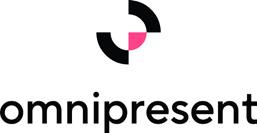
Paycom (NYSE:PAYC) offers cloud-based human capital management software to help businesses streamline employment processes, from recruitment to retirement. With a robust suite of products including payroll, time and labor management.

Jobvite is leading the next wave of talent acquisition innovation with a candidate-centric recruiting model that helps companies engage candidates with meaningful experiences at the right time, in the right way, from first look to first day.

Designing better ways to work by providing cutting-edge products and exceptional experiences within HR, Talent, Time Management, Benefits and Payroll.
 LEARN MORE
LEARN MORE
LEARN MORE
LEARN MORE
LEARN MORE
LEARN MORE
LEARN MORE
LEARN MORE
February 15-16, 2023
January
February

